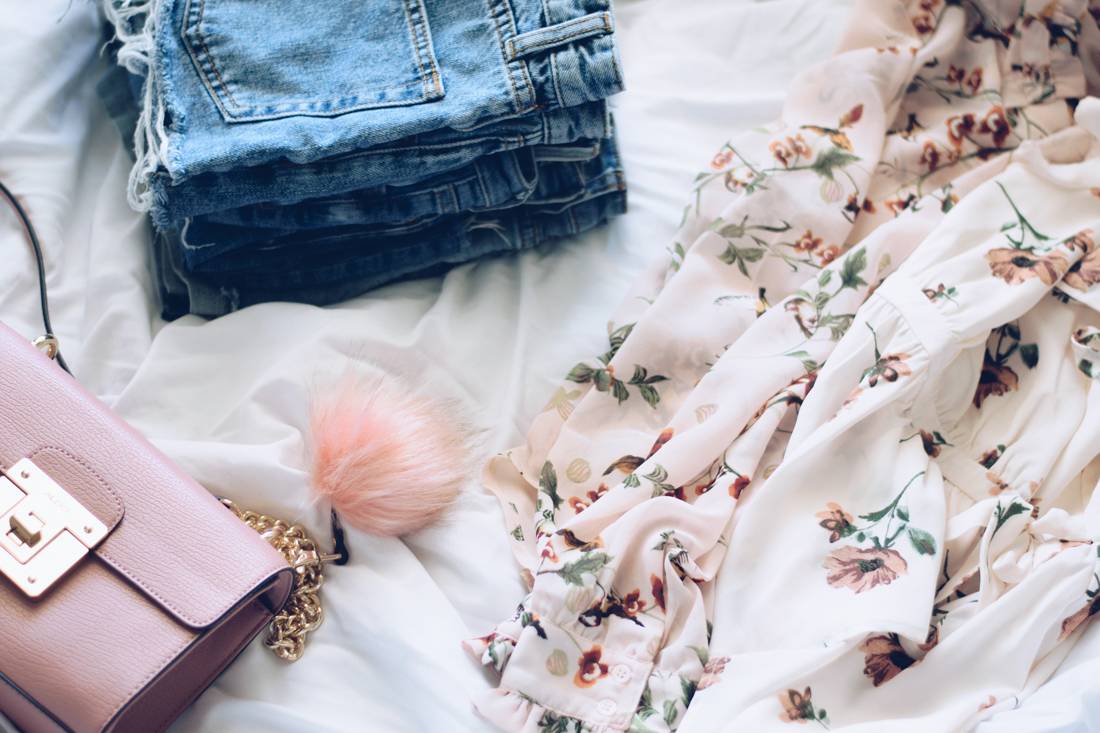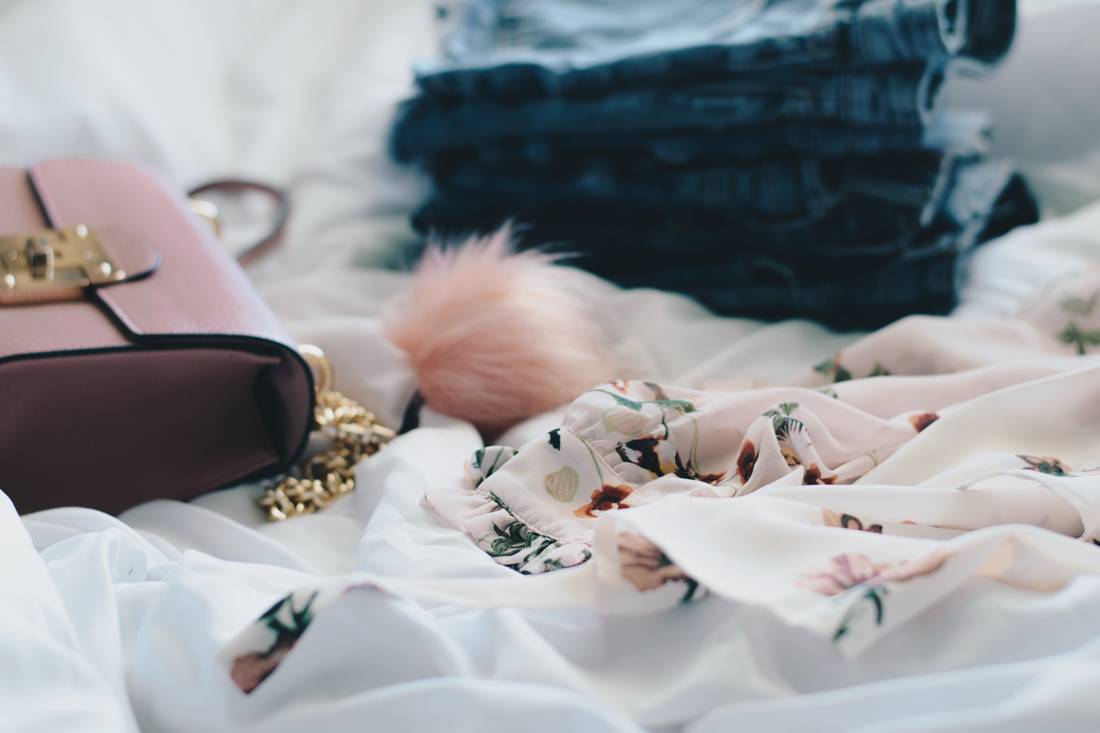We’re officially in a new season! In a previous post, I shared three tips to help you transition your style for the season. Today, we’re diving deeper into the first tip highlighted:
Out with the old, in with the new! Declutter your closet to make room for incoming spring items.
I know what you’re thinking–decluttering a closet will take forever! Don’t worry, the key to effectively organizing your closet is to have a plan before getting started. Below are the four steps I use to declutter my own closet, which I hope you’ll find helpful. Pro Tip: Another way to minimize the time spent decluttering is to do this on a regular basis! At a minimum, it’s a good idea to declutter your closet on a quarterly basis to align with the seasonal changes. This gives you a chance to shift heavy coats to a confined space while they aren’t in use and toss any items that won’t be worn in the future.

Step One | Empty your closet.
Yes…you read that right. EMPTY your closet.
In the past, I would have recommended that you take everything out of your closet and take them off the hanger. Through trial and error, I’ve found that it’s less exhausting and more efficient to eliminate the latter. While you should still empty your closet, try to do this gently and keep as much as you can on hangers while laying everything on your bed. I realize this step can be intimidating, but it is extremely necessary to fully empty out your closet.
Why?
I’m glad you asked! You need to empty your closet when decluttering for two main reasons:
- It forces you to revisit every single piece of clothing you own. When you try to organize a closet without emptying it and starting from scratch, you tend to overlook the items that haven’t been touched in years. Rather than using this opportunity to get rid of those items, we’ll instead keep them in the closet simply because it’s easier. Over time, this is how you end up with a rack of clothes that no longer fit or make sense for your lifestyle. Don’t give yourself the opportunity to overlook. Take a deep breath, eat a good meal so you have energy prior to starting, and empty out your closet.
- Emptying out your closet also forces you to finish what you started. Too many times we commit to doing something only to get tired midway through and stop. To be totally transparent, I find this to be something I struggle with when I set lofty or time-consuming personal goals. Doing this step eliminates that option. By emptying out your entire closet and laying everything on your bed, you have to finish. Otherwise, you’re left with a pile of clothes resting on the place you sleep and a closet with 5% of your wardrobe.
Step Two | Create three piles for sorting.
This is a pretty common practice when it comes to decluttering your closet, and for good reason. Trust me when I tell you this method works. I’ve tried a few different methods when deciding what I should and shouldn’t keep in previous closet clean-outs over the years, but the three pile method is what I’ve found to be the most effective. So, what are the three piles?
- The Keep Pile
- The Donate Pile
- The Store Pile.
The ‘Keep’ Pile
This will likely be the largest pile, but it’s also the one you have to be very mindful of throughout your sorting process. Remember, the goal of this project is to remove the excess so your closet is filled with items you actually wear. You want to avoid making this pile unnecessarily huge. Anything you no longer want, fit, or can wear due to damage should make its way over to the keep pile.
When picking up each article of clothing, things that should go in the keep pile are items that you do not have to second-guess and are wearable for the current season. You shouldn’t have to spend more than a few seconds deciding whether or not an item adds value to your wardrobe. This pile should hold the no-brainers. For example, my keep pile will automatically include my leather jacket because I wear it often, it’s in good condition, and it’s a closet staple. The keep pile would not contain my pink wide-leg pants. Although I’d be hesitant to toss them because they are in good condition and fit, I would let them go because they simply do not fit my lifestyle and I haven’t worn them in several years. What are the chances I’d magically wear them now? Slim to none.
Note: If you absolutely can’t fathom getting rid of those ‘maybe’ items immediately, I understand your pain! This part takes time and practice, so you may want to consider adding a fourth pile: the maybe pile. If you do this step, I recommend going through the sorting process once for your full closet. After the first run-through is complete, there are two methods you can use to get through the maybe pile.
- Put the maybe pile in a bin or bag and set it aside for a month. If you don’t reach for anything in the bag, then you know it no longer serves you. If you reach in and grab a specific item, then it stays in your closet. Simple! This method will keep your closet in the ‘ideal’ state while you reconsider whether or not your closet is missing anything critical.
- The second method is more of an immediate fix. Once you complete the first run-through of sorting your closet, specifically go through the maybe pile one more time. After sorting your full closet, you’re more aware of the things you own so it makes it easier to make a firm decision on each maybe piece. Try things on if you have to!
The ‘Donate’ Pile
The donate pile is usually the smallest pile because we have a hard time letting things go–hence why I also recommended adding a fourth pile for those struggling with the sorting process. For help determining which items should go in the donate pile, ask yourself a few questions:
- Have you worn the item in the past year or two?
- Do you feel like the item accurately represents your style?
- Does the article of clothing comfortably fit?
- Is the item still in good condition?
- Does the item blend with your current lifestyle?
If the answer to all of those questions is yes, place the item in the keep pile. If the answer to one or more of those questions is no, it’s time to donate. Of course, the items that are no longer in good condition should be tossed instead of donated depending on the severity of the damage.
The ‘Store’ Pile
The storage pile helps you declutter your closet at the end of the season. This pile will hold items you want to keep and will regularly wear, but they just may not be appropriate for the upcoming season. Things like heavy jackets, outerwear, and scarves may end up in this pile during a spring declutter session. In the wintertime, you’ll likely store shorts and crop tops.
In the past, I lumped all of these items in the ‘keep’ category and would go through them a second time once the keep and donate piles were clearly separated. I have found that it’s easier to separate these piles from the very beginning. Doing this from the start prevents the double work of having to go back through your keep pile to remove seasonal pieces. Unless you plan to keep seasonal items in your wardrobe year-round, the store pile is a must.
Step Three | Donate (or sell) everything in the donation pile.
This step is something I recommend doing immediately on the same day. If you push the act of donating to a later date, you’ll increase your chances of giving up and just keeping everything. Then, you’ve ultimately spent time sorting and decluttering for nothing. To avoid falling into that trap, take a break before you get to the last step and get rid of your items. You can do this by:
- Donating to your local women’s shelter
- Listing items on Poshmark
- Dropping off clothes to your local consignment shop
Which option you choose is completely up to you! Most often, you may find yourself doing a mixture of all three. If you have designer items that are in good condition, it’s probably a good idea to list them on Poshmark (or TheRealReal for luxury items) so you can earn some of what you spent back. While you may receive money, it will take more time to list the items versus donating so just keep that in mind.
If you want to spend less time listing items but still want to earn money for your items when available, you can try dropping off your clothes to a local consignment shop. To be totally frank, they will give you much less than what they should so it may not be worth doing if you don’t have at least a bag’s worth of items. That being said, it is an option and will typically take less than an hour to complete. Anything they don’t accept because they think it’s out of season (disclaimer: this is also oftentimes inaccurate), you can donate.
If the selling options sound like more trouble or time than you care to dedicate, donating is always available! It’s also extremely helpful for those in need! Instead of listing items or going through the slightly frustrating process with a consignment shop, you can choose the quickest option of donating items to a local women’s shelter or donation station.

Step Four: Put Your Clothes Away.
I know, I know. By the time you get to this step, it is so tempting to save it for the next day. Trust me, you’ll want to get this part out of the way as soon as possible. You’re already at the last actionable step for the day so you might as well see it through to the end. You’ll be happy once it’s over and have the rewarding satisfaction of checking this task off your to-do list. Because you’re prepping for the upcoming season, there are three ways you can separate your wardrobe:
- Keep a spring clothing rack separate from your usual wardrobe.
- This is my preferred method because it provides me greater visibility to the items I want to wear within a given season. The goal here is to wear all of the items on your seasonal rack regularly while being mindful of how full the rack gets. If you’re like me and want to minimize your wardrobe size, a seasonal clothing rack will help keep you honest.
- If you choose to organize with this method, sort the clothes in your closet by color and leave the spring essentials hanging on a separate clothing rack.
- Separately store the winter items until the end of the year.
- If you like to keep your clothing contained within a single space, this may be the better option for you. Rather than displaying spring items on a separate rack, pull out the winter items and tuck them away in vacuum-sealed bags.
- With this method, your stored clothes will not take up space in your closet and will still be available next year.
- Similar to the first option, organize your spring clothing within your closet by color and article type.
- Keep your full wardrobe in one single closet regardless of season and sort by type and/or color.
- If you don’t want to purchase a separate clothing rack or separate storage bags, this last option is for you. This is also a good option for those of you who live in an area where the season doesn’t necessarily dictate the climate.
- With this sorting option, you’ll have easy access to your full wardrobe year-round.
Once everything is put away, you’re officially finished! With a newly organized closet, you can now make a list of the essential items to purchase for the season because you have an idea of what’s missing in your wardrobe. If you’re looking for spring fashion inspiration, I recently shared a collective haul over on YouTube! Check it out below to see which spring items you can add to your newly decluttered closet:
I hope you found this post helpful as you prepare your wardrobe for spring. I’ve included a few closet storage and clothing rack options at the end of this post to browse through for inspiration!
Which storage method will you use this season?
FTC: Affiliate links are used within the post, meaning, a small commission is received when purchases are made through the links. Please show your support by shopping the links provided–it’s greatly appreciated and keeps the site running!




Comments +